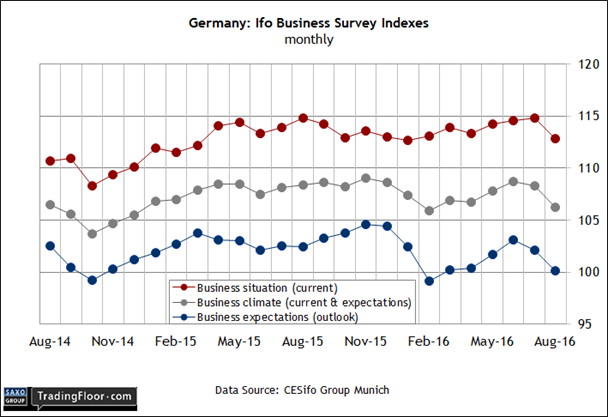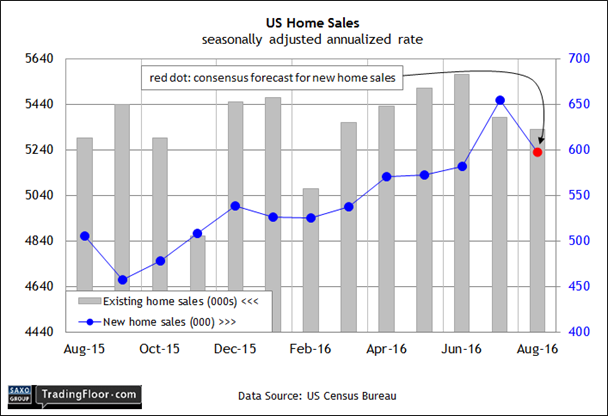- Will Germany’s “summer slump” spill over in today's Ifo sentiment data?
- New US home sales for August are expected to tumble
- Will USD/JPY dip below the 100 mark this week?
Germany’s economy is in focus today with the monthly update of the Ifo Business Climate numbers for September.
Later, the August data on new home sales is Monday's main event for US data. Meantime, keep an eye on USD/JPY, which will be under close scrutiny in the wake of last week’s announcement by the Bank of Japan of a major revision for monetary policy.
Germany: Ifo Business Climate (0800 GMT): Economic growth in Europe’s main economy continued to slow in September, according to preliminary sentiment data published by IHS Markit on Friday.
The flash reading of the Germany Composite Output Index, a proxy for the official GDP numbers, dipped to 52.7, the lowest level since early 2015. Although that’s still above the neutral 50 mark, the dip implies that growth is at risk of ongoing deceleration for the rest of the year.
“The upturn in Germany’s private sector economy is losing further momentum, with latest survey data pointing to the slowest expansion in output for nearly one-and-a-half years,” an IHS Markit economist said.
"While further GDP growth is expected, it is highly unlikely that the 0.7% rate seen at the beginning of the year will be repeated.”
Today’s update on business sentiment via the Ifo release for September offers another benchmark for deciding if Germany’s macro trend is downshifting.
Recent updates aren’t encouraging. “The German economy has fallen into a summer slump,” the president of the Ifo Institute said last month.
The question is whether the slump will carry over into September?

US: New Home Sales (1400 GMT): Sales of existing homes fell in August, the National Association of Realtors (NAR) reported on Thursday.
Economists were expecting a modest gain. Is that a sign that the housing market is stumbling? Today’s profile of the market for newly built houses may provide a clue.
To the extent that existing transactions are a guesstimate of things to come, the latest dip is partly due to a slide in the available inventory of homes for sale.
“Healthy labor markets in most the country should be creating a sustained demand for home purchases,” NAR’s chief economist said last week.
“However, there’s no question that after peaking in June, sales in a majority of the country have inched backwards because inventory isn't picking up to tame price growth and replace what's being quickly sold.”
The subtle implication: Fundamental demand is still robust, even if supply can’t keep up. If so, today’s numbers on new homes will provide a reality check.
The crowd, however, is skeptical that the appetite for purchasing remains healthy. New home sales are expected to stumble in August, falling sharply to a seasonally adjusted annual rate of 598,000, according to Econoday.com’s consensus forecast.
But that still leaves this measure of sales close to the highest level since 2008. Nonetheless, another soft update for housing will keep the market on edge and raise questions about the outlook for demand in the fourth quarter.

USD/JPY: The Bank of Japan last week announced that it will raise its inflation objective above its previous 2% target. The central bank also decided to establish a floor for the 10-year government bond yield at zero.
That’s low by US standards, but in the deflationary world of Japan a 0% yield is ambitious – the current 10-year yield, as of Friday: negative 0.05%.
The shift in BoJ’s strategy is considered risky, in part because failure might create an even bigger problem for Japan’s already challenged monetary policy, which is trying (with limited success) to extinguish the deflationary bias that weighs on the economy.
Skeptics of the new plan say that there’s a reason why central banks haven’t tried yield-curve targeting on the long end in decades: It’s an unwieldly and risky method for managing monetary policy.
One concern is that the new plan could backfire by laying the groundwork for an even stronger yen, which would strengthen the deflationary bias.
Meantime, the Bank of Japan appears a bit desperate and the market smells blood. “The BoJ’s decision is evidence of its policy exhaustion,” writes the managing director in PIMCO’s Tokyo office.
Traders will be closely monitoring the yen this week for signs that the rally that’s been underway in 2016 so far will push USD/JPY below 100 (lower USD/JPY levels indicate a stronger yen).
The bulls nearly breached that mark last month and recent trading action suggests that another run below 100 is still a possibility. Indeed, the downside momentum for USD/JPY remains intact, as the chart below reminds.
But with a light economic calendar for Japan over the next several days, USD/JPY may churn in a trading range at just above 100.
Barring any major announcement from BoJ, however, the possibility that USD/JPY will fall below 100 in the near term can’t be ruled out.

Disclosure: Originally published at Saxo Bank TradingFloor.com
